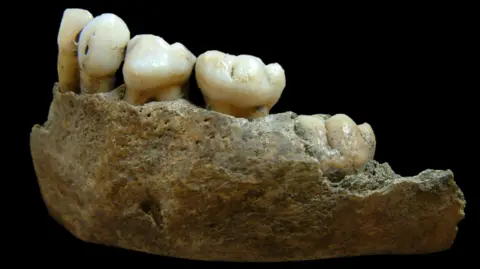Lack of sunlight 'cause' of rickets, say scientists
 Durham University
Durham UniversityA lack of sunlight may have caused rickets in people from north-east England during the Industrial Revolution, scientists say.
Researchers studied the teeth of 25 people from a Quaker burial site at Coach Lane in North Shields.
They found many of them had severe vitamin D deficiencies, which seemed to be particularly worse during the winter.
This was probably due to lack of sunlight in the region, said Prof Rebecca Gowland of Durham University.
The research, undertaken by an international team of scientists, was published in the journal PLOS ONE.
Seasonal
Humans produce about 90% of vitamin D levels in skin from contact with sunlight, said Prof Gowland, while the other 10% is from our diet.
Vitamin D is needed to keep bones, teeth and muscles healthy, as well as being important for the immune system.
High levels of vitamin D deficiency can lead to conditions such as rickets, which causes soft and weakened bones in infants and children.
The researchers found that 76% of the people they studied, who were mostly children, had vitamin D deficiency.
This seemed to get worse during the winter.
Researchers could tell that this effect was seasonal, as teeth tissue grow in cycles during childhood. This meant the team could see that the disruption to tissue caused by vitamin D deficiency happened relatively regularly, and could be linked to winter months.
'Pollutants'
Even today, people living in north-east England are typically somewhat vitamin D deprived during winter, said Prof Gowland.
But the levels of vitamin D deficiency seen in these people, who are believed to have been alive in the 18th and 19th century, are far more severe than is typically seen today in the UK.
“If we think about North Shields [at the time], there’s all kinds of industries going on there - factories spurting out pollutants into the atmosphere which will affect the amount of sunlight people get,” said Prof Gowland.
People are also likely to be vitamin D deficient if they spend all day working in a factory, she says.
All these factors, combined with the lack of sunlight seen in North Shields during winter months, could play a role in the high level of vitamin D deficiencies seen in these people, said Prof Gowland.
“I think no matter who you are, if you’re living in that area in the North East, you’re going to be exposed to some kind of environmental constraints,” she added.
Follow BBC North East on X (formerly Twitter), Facebook and Instagram. Send your story ideas to [email protected].
